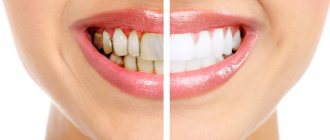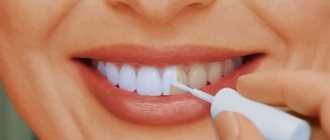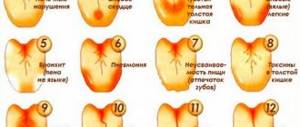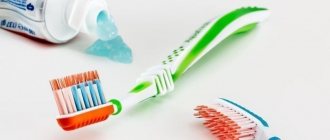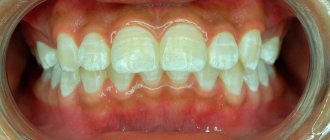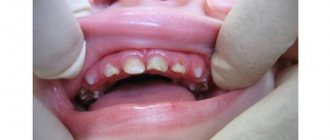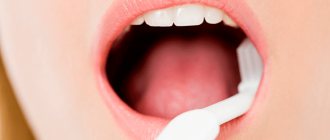Heavy smokers always have a yellow or brown tint to their enamel. This violates the overall aesthetics and makes you think about how to remove plaque on teeth after smoking and whether this can be done at home. Any dental plaque is a source of infection that can spread to nearby tissues. Therefore, you should treat cigarette residue responsibly and use all possible ways to eliminate it.
Ideally, it is better to quit smoking. Nicotine, tar and other chemical compounds negatively affect the health of the oral cavity and respiratory system, and increase the risk of developing severe infectious diseases. But not everyone can give up years of smoking. In this case, it is important to regularly visit the dentist and use methods that allow you to remove plaque on your teeth after smoking without harm to your health.
Consumption of certain foods and drinks
Black plaque as in the photo often appears in those people who love strong tea and coffee without milk, red wine, Coca-Cola, dark chocolate, currants, blueberries, and pomegranates. The fact is that these products contain a large amount of dyes and polyphenols, which color the enamel in an unpleasant dark shade. Polyphenols are powerful antioxidants, but frequent consumption of foods rich in these substances and lack of basic oral hygiene after eating and drinking play a cruel joke on some people.
The photo shows stains from tea and coffee
If you do not want your teeth to become covered with black plaque, then after eating food and drinks, do not forget to thoroughly rinse your mouth with water or mouthwash. In the evening and morning, be sure to clean with paste, brush, floss and irrigator. If the pigment does appear, then a complex of professional hygiene at the dentist will help to cope with it.
We must also not forget that some of these foods and drinks (coffee, sweet carbonated drinks, berries) have high acidity, due to which the enamel becomes more porous and rough, which means that any pigment penetrates into it more easily.
Preventive actions
Prevention of dental plaque looks like this:
- constant cleaning of teeth. This should be done after meals and before bed. It is necessary to treat not only the teeth, but also the tongue. Additionally, it is recommended to use antibacterial floss;
- use of antibacterial rinses. They are used after brushing your teeth. Good resources are available from;
- reducing the use of nicotine products;
- If possible, avoid caffeine.
Excess iron in the body
In the oral cavity of any person there is a large number of bacteria, including actinomycetes. In the process of their life activity, they produce hydrogen sulfide, which, when interacting with iron (contained in saliva, red blood cells, gingival fluid), contributes to the staining of teeth in black and brown shades.
Which leads to the problem:
- taking antibiotics and vitamins with iron: of course, if you have just started taking such medications, do so according to your doctor’s instructions and strictly follow the instructions (iron is taken in courses), then the problem is unlikely to arise. If you start taking medicine without a prescription or take it for a long time, then your teeth may turn black,
- using tap water with a high iron content for preparing food and drinks,
- work in hazardous industries associated with the processing of iron, as well as copper, manganese, nickel: when inhaled, particles of harmful metals settle on internal organs and teeth.
Excess iron can also stain teeth black
“My child was 3 years old when the doctor suggested strengthening his teeth with silver. This proposal arose due to the fact that we had caries. Without hesitation, I agreed, and then I really regretted it, because after silvering, the enamel became very black after some time and now we don’t know how to get rid of it. But the doctor didn’t even warn about such consequences!”
Baby_mama, review from babyblog.ru
Reasons for appearance
When you eat, bacteria settle and build up on your teeth's enamel. In the absence of regular teeth cleaning, the number of accumulated microorganisms increases, which leads to the appearance of pigmented plaque .
In an adult
The orange tint is due to the accumulation of waste products of chromogenic bacteria. Microorganisms are colorless, coloring pigments are deposited nearby, in the form of tiny drops, crystals, coloring the environment.
Bacteria have the ability to cause fermentation and decay processes, which leads to loosening and loss of teeth, and the appearance of caries.
Orange plaque is localized in the cervical area of the teeth (usually incisors); the color varies from light orange to brick-red.
In adults, the appearance of such plaque can be caused by the following reasons:
- taking medications, in particular antibiotics;
- rinsing the mouth with solutions of Ethacridine, potassium permanganate and others;
- eating food with coloring components (coffee, tea, red wines);
- disturbance of intestinal flora, dysbacteriosis;
- smoking - nicotine forms a thin film, as a result of which food particles stick to the tooth surface more intensely.
The reasons that contribute to the formation of an orange plaque in a child are also the waste products of chromogenic bacteria. Children from 5 to 15 years of age are more susceptible to microorganisms than adults due to the composition of saliva (low bactericidal properties due to a small amount of lysozyme) or the onset of puberty. The appearance of a bacterial film can also be influenced by :
- A pathological change in the composition of saliva formed at the stage of intrauterine development.
- Intestinal dysbiosis, inflammatory processes of the biliary tract.
- Frequent drinking of sweet, pigmented drinks, excessive consumption of chocolate, fruits and vegetables containing carotenoids (plant colorants) - carrots, tomatoes, peaches, melons and others.
- Regular consumption of food that does not require thorough chewing, malocclusion.
- Inflammatory processes in the oral mucosa, leading to thinning of the pellicle (protective film), enamel and, as a result, the appearance of microcracks in which bacteria accumulate and multiply.
A bright orange plaque with a reddish tint may indicate that the child has a hereditary disease - porphyria, which is associated with a violation of tissue pigmentation.
Abuse of chlorhexidine-based mouthwashes
Teeth inevitably become covered with black plaque if you rinse your mouth with Chlorhexidine or rinses that contain this medicinal substance for a long time. Chlorhexidine fights bacteria and viruses well, helps eliminate the inflammatory process in the mucous membrane, helps damaged tissues recover faster, reduces bleeding gums, but it cannot be used for longer than 10–14 days in a row.
The enamel can also darken due to the abuse of rinses that contain benzalkonium chloride, as well as essential oils. Products with such components are not suitable for daily use. They are used only in courses and according to indications, for example, in complex therapy for the treatment of gingivitis or periodontitis.
Reasons for appearance
When you eat, bacteria settle and build up on your teeth's enamel. In the absence of regular teeth cleaning, the number of accumulated microorganisms increases, which leads to the appearance of pigmented plaque .
In an adult
The orange tint is due to the accumulation of waste products of chromogenic bacteria. Microorganisms are colorless, coloring pigments are deposited nearby, in the form of tiny drops, crystals, coloring the environment.
Bacteria have the ability to cause fermentation and decay processes, which leads to loosening and loss of teeth, and the appearance of caries.
Orange plaque is localized in the cervical area of the teeth (usually incisors); the color varies from light orange to brick-red.
In adults, the appearance of such plaque can be caused by the following reasons:
- taking medications, in particular antibiotics;
- rinsing the mouth with solutions of Ethacridine, potassium permanganate and others;
- eating food with coloring components (coffee, tea, red wines);
- disturbance of intestinal flora, dysbacteriosis;
- smoking - nicotine forms a thin film, as a result of which food particles stick to the tooth surface more intensely.
The reasons that contribute to the formation of an orange plaque in a child are also the waste products of chromogenic bacteria. Children from 5 to 15 years of age are more susceptible to microorganisms than adults due to the composition of saliva (low bactericidal properties due to a small amount of lysozyme) or the onset of puberty. The appearance of a bacterial film can also be influenced by :
- A pathological change in the composition of saliva formed at the stage of intrauterine development.
- Intestinal dysbiosis, inflammatory processes of the biliary tract.
- Frequent drinking of sweet, pigmented drinks, excessive consumption of chocolate, fruits and vegetables containing carotenoids (plant colorants) - carrots, tomatoes, peaches, melons and others.
- Regular consumption of food that does not require thorough chewing, malocclusion.
- Inflammatory processes in the oral mucosa, leading to thinning of the pellicle (protective film), enamel and, as a result, the appearance of microcracks in which bacteria accumulate and multiply.
A bright orange plaque with a reddish tint may indicate that the child has a hereditary disease - porphyria, which is associated with a violation of tissue pigmentation.
Multiple caries
Caries is not plaque, but a dental disease. However, it is precisely when the teeth become black. It should be noted that in the early stages of development, white or yellowish spots appear on the enamel, but they become black only as the tooth decays and the disease progresses.
Black color can also indicate the presence of tooth decay
A tooth can turn black due to injury and death of the pulp, or if it is depulped. In this case, the problem of smile aesthetics, depending on the clinical picture, can be solved by intracanal whitening, installation of veneers or crowns.
“Bottle” caries is common in children, in which the teeth, especially the front ones, become very black. If you do not want to face this problem, then do not give your baby sweet mixtures and juices at night.
“My tooth, on which there was a filling, turned black, it turned black right along the edge. I didn’t pay attention to it for a long time, because it was chewy—the blackness was not visible. I went to the doctor only when pain appeared. It turned out that the filling had moved away from the walls of the tooth and began to fit loosely, which I did not notice. Bacteria penetrated there and gradually repeated caries formed ... "
Larisa N., review from woman.ru
Laser cleaning
This is an innovative, gentle and painless method of cleaning teeth from plaque of any color (black, yellow, etc.). During the procedure, the enamel is not damaged, and there is virtually no gum bleeding. Although this method of dealing with deposits is expensive, the investment is completely justified.
Benefits of laser teeth cleaning:
- removal of plaque and tartar, regardless of location;
- low level of pain, and therefore local anesthesia is not required;
- the ability to regulate the intensity of the impact;
- absence of noise and vibration, which is important for patients with dental phobia;
- non-contact - the device does not come into contact with tissues;
- safety of the procedure - the formation of enamel microcracks is excluded;
- no gum bleeding - even if tissue is damaged, the blood immediately coagulates under the influence of the laser;
- minimal risk of complications - the beam has a disinfecting effect, so during the procedure all pathogenic microorganisms are killed;
- rapid tissue restoration - due to stimulation of trophism and reparative processes;
- lightening the enamel by 1-3 tones;
- long-term effect - no plaque on the teeth for a year, provided proper care of the teeth and the oral cavity.
Laser deposit removal can only be performed by adults (over 18 years of age). It is not given to pregnant and lactating women if the patient has inflammation of the oral mucosa, severe heart pathologies or infectious diseases. Also contraindications are AIDS, HIV, bronchial asthma, chronic bronchitis.
Priestley's Raid
The Priestly plaque on the teeth that you see in the photo occurs only in children. Adults do not have this problem. Pathology appears on milk units due to the characteristics of the microflora of the oral cavity and the presence of bacteria in it, which make the enamel black.
The photo shows Priestley's raid
It is believed that this problem does not pose a potential threat to the child’s health, but it is a serious aesthetic defect that one would like to get rid of. Fortunately, today doctors know methods that will help remove black plaque and put teeth in order. If you bring your child to the dentist, the specialist will carefully remove the pigment and polish the enamel using sandblasting machines, pastes and silicone brushes.
Remember that Priestley's nonspecific plaque may appear again a few months after cleaning at the dentist. To prevent this from happening, you need to reduce the activity of the bacteria that provoke it. Eliminating dysbiosis and maintaining good immunity in the child will help with this.
Degrees of formation
Dentists distinguish 3 stages of plaque formation:
- (240 minutes after brushing teeth). The stage is characterized by the proliferation of remaining bacteria, which begin to quickly spread throughout the oral cavity;
- (duration – 4-7 hours). Lactobacilli and streptococci are attached to the enamel. As a result, soft plaque is formed;
- (starts at the end of 7 hours). Deposits become visible to the naked eye. They contain anaerobic bacteria.
The soft plaque, under the influence of microbes found in saliva, gradually thickens and hardens - the process of mineralization occurs.
The resulting tartar compresses the gingival grooves. Against the background of their constant irritation between tissues and saliva, metabolism is disrupted.
Gradually, the enamel is damaged, and an inflammatory process develops in the gums. It is initiated by a special microflora of dental plaque. Over time, the pathology affects the deeper layers.
The Silnes-Low index helps to examine all or some of the teeth. Their condition is assessed on a scale:
- 0 – there are no deposits in the gingival area;
- 1 – only a probe helps determine a thin film;
- 2 – in the cervical zone and gingival groove, deposits are visible to the naked eye;
- 3 – there is plaque between the teeth.
Diseases of the body
Black plaque on the upper and lower teeth can occur in those who have general systemic diseases of the body. Most often, pathology appears if a person has problems with the gastrointestinal tract: high acidity, gastritis, ulcerative lesions, dysbiosis, gastroduodenal reflux (when bile from the duodenum is thrown into the stomach or from the stomach into the esophagus), bending of the gallbladder. Teeth can turn black due to problems with the liver and kidneys, bile ducts, and dysfunction of the endocrine system.
Removing black plaque or performing whitening procedures in a dental office will be short-lived, ineffective and pointless if you are not going to treat the underlying disease of the body that caused the problem.
Problems with the gastrointestinal tract can also cause the problem
Plaque on children’s teeth: photo, what it means, how to treat it
Recently, enamel defects can be increasingly observed in young children, starting almost from infancy.
Parents of a child who notice problems with teeth begin to worry greatly, and rightly so, because any darkening, holes and plaque are harbingers of future diseases in the oral cavity and, as a result, damage to the child’s body as a whole .
It is best to solve problems of this nature when the first signs appear, in order to identify the cause of tooth damage in time and begin effective treatment.
Smoking cigarettes and cigars
Black-brown plaque, tightly adjacent to the necks of the teeth on the inside of the row, appears as a result of smoking. In the process of smoking a cigarette or cigar, resins and carcinogens are deposited on the enamel, which contribute to pigmentation. This bad habit provokes the emergence of many dangerous problems and dental diseases. Which ones? You can read more about this in the feature article on our website.
Do not forget that by consuming cigarettes, you expose the enamel to strong temperature changes, due to which it cracks, and any pigment from food and drinks gets into the cracks much more easily.
Notice
: Undefined variable: post_id in
/home/c/ch75405/public_html/wp-content/themes/UltraSmile/single-item.php
on line
45 Notice
: Undefined variable: full in
/home/c/ch75405/public_html/wp-content /themes/UltraSmile/single-item.php
on line
46
Rate this article:
( 1 ratings, average: 5.00 out of 5)
plaque
- Evteev S.S., Lebedeva S.N., Kharitonova T.L. Etiological factors of dental discoloration // Bulletin of medical Internet conferences. – 2021.
Expert “In order to prevent plaque from spoiling your smile, you need to undergo preventive examinations at the dentist and professional hygiene twice a year. It must be remembered that plaque can form not only on natural teeth, but also on artificial materials used for restorations. Restored teeth also require careful hygienic care.” Dentist-therapist Belyaeva Olga Aleksandrovna
Consulting specialist
Dzagurova Elina Ruslanovna
Doctor rating: 9.5 out of 10 (2) Specialization: Dentist-therapist Experience: 10 years
Localization
A distinctive feature of yellow enamel is its hardness, and no matter where it is, it is quite difficult to remove it without harming the teeth.
Teeth turn yellow at the roots
Yellow plaque on teeth most often forms at their roots, and this localization is due to the following reasons:
- bad habits. If this is the case, the whitening procedure will be quite easy;
- constant change of different diets. Teeth react sensitively to changes in taste preferences, and the lack of proper balance in the diet causes plaque;
- injuries. For example, an impact damages the pulp area;
- age;
- improper hygiene;
- the use of braces in the absence of normal care for them.
Yellowed on the front surface
This yellow plaque develops on the smooth surface of the tooth in front, and can also fall closer to the edge of the gum.
These deposits are the most noticeable because they are on the outer side of the enamel.
On the back side
This type of plaque is dangerous because, being on a contact surface, it appears directly during chewing of food.
To put it differently, the cause of the appearance of such deposits is plaque that specifically affects the inside of the tooth.
Comments
Recently, my wisdom tooth, which had been in for sooo long, finally came through completely. But it came out black and ached a little when pressed. What could it be?
Alice (04/12/2020 at 5:14 pm) Reply to comment
- Dear Alice, perhaps the wisdom tooth was affected by caries, pulpitis or periodontitis even before it completely broke through. You need to be examined by a dentist to find out the cause of the problem and begin treatment. If treatment is not practical, the tooth will have to be removed.
Editorial staff of the portal UltraSmile.ru (04/17/2020 at 09:17) Reply to comment
I heard that some materials that dentists use to treat teeth can cause blackening of the enamel. Is this really so, what to fear during treatment?
Lyubov Vladimirovna (04.05.2020 at 12:21) Reply to comment
- Dear Lyubov Vladimirovna, in the past, dentistry actually used materials that could cause darkening of teeth, for example, silver amalgam fillings, but today they are not used, so treat your teeth without fear.
Editorial staff of the portal UltraSmile.ru (05/11/2020 at 09:20) Reply to comment
I have a very dark coating on my nylon dentures, can I bleach it?
Alexander Mikhailovich (05.28.2020 at 22:17) Reply to comment
- Dear Alexander Mikhailovich, nylon absorbs various dyes well and requires daily and very careful care. Unfortunately, artificial denture materials cannot be bleached. You, of course, can try to clean them with special tablets or take them to the dentist for professional cleaning, but such a measure will not remove deeply ingrained pigment; it will only remove superficial stains and destroy bacteria.
Editorial staff of the portal UltraSmile.ru (06.06.2020 at 14:09) Reply to comment
Write your comment Cancel reply
What to do?
Many people want to clean their teeth from plaque at home. To do this, they use special bleaching pastes, soda, activated carbon, 3% hydrogen peroxide solution, and lemon juice. Sometimes, with slight darkening of the enamel, these methods give the desired effect.
But if you abuse such bleaching, as well as in case of increased sensitivity of the enamel, you can only harm yourself. Therefore, if you want to return your teeth to a snow-white shade, you need to start with a visit to a specialist. The dentist will assess the condition of the enamel, identify diseases of the oral cavity (if any) and recommend the best option for cleaning teeth from plaque.
In a clinical setting, there are several ways to get rid of deposits. Let's consider them in as much detail as possible. This will allow you to go for a consultation with a “theoretical savvy” specialist.

